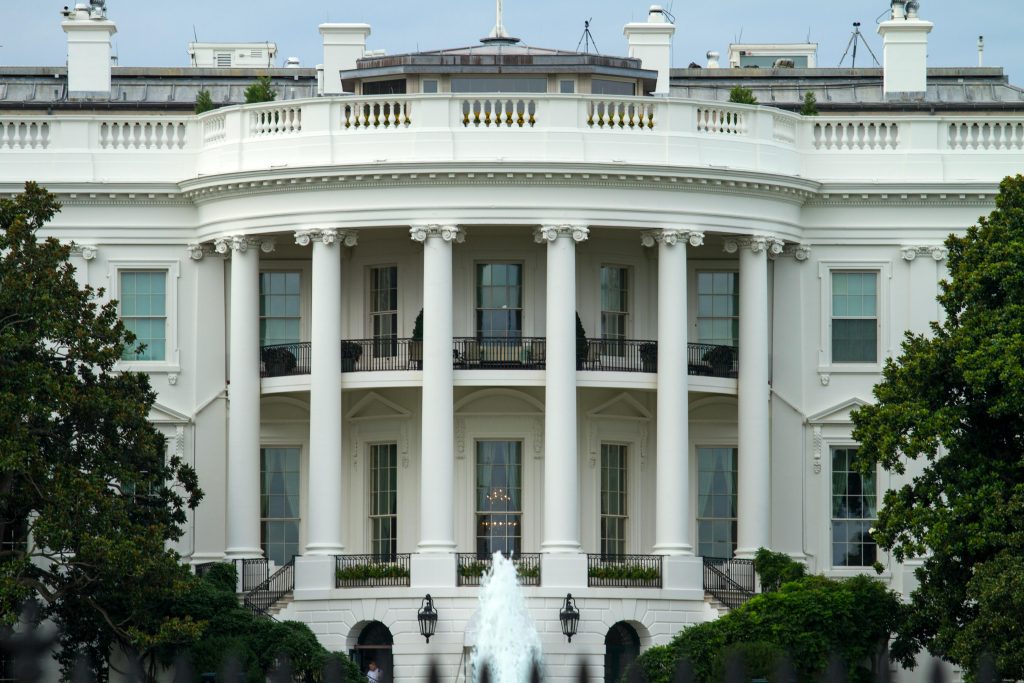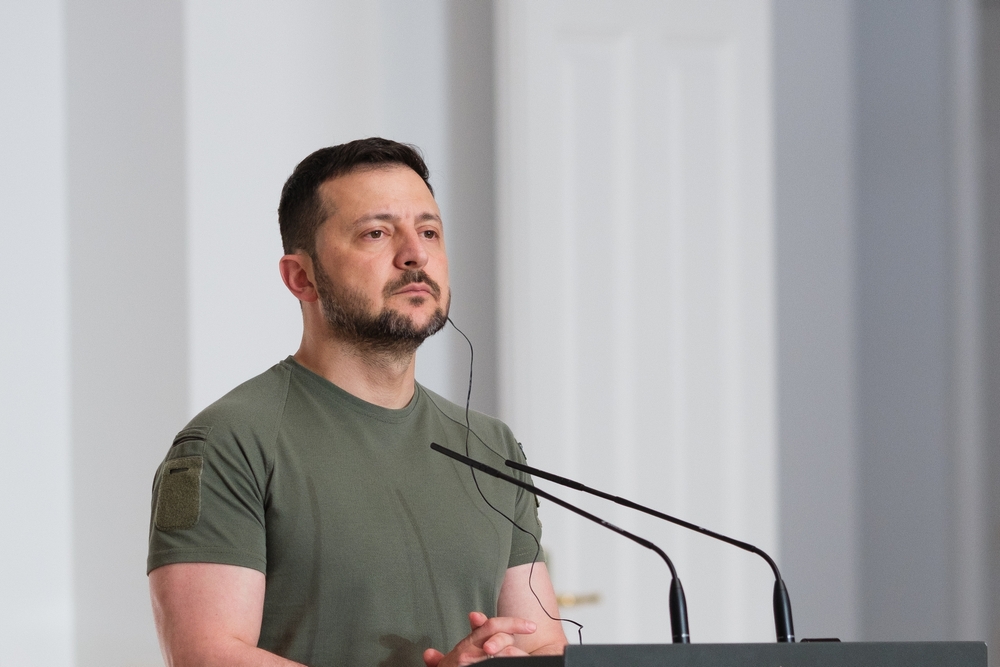Your cart is currently empty!
Zelenskyy Had ‘Epic’ Comeback to Reporter Who Grilled Him for Not Wearing a Suit in First Meeting With Trump

In politics, clothing often speaks before a word is uttered. Winston Churchill’s homburg hat, Jackie Kennedy’s pink suit, Barack Obama’s famously criticized “tan suit” history is full of moments where attire carried as much weight as rhetoric. For Ukrainian President Volodymyr Zelenskyy, who has spent the past two years in olive drab and military black, fashion has been more than personal style; it has been a symbol of solidarity with soldiers on the front lines.
So when Zelenskyy arrived at the White House in a tailored black jacket and trousers during his latest meeting with Donald Trump, the sartorial shift was already noteworthy. What followed, however, was an exchange that went viral: a wry comeback to the very reporter who once chastised him for refusing to wear a suit. With a single line, Zelenskyy reminded his critics that while he adapts to circumstances, his humor and resolve remain unchanged.
The Viral Exchange at the White House
What might have been a routine compliment quickly turned into the most replayed moment of President Volodymyr Zelenskyy’s latest visit to Washington. As he entered the Oval Office dressed in a sleek black suit designed by Ukrainian fashion house Viktor Anisimov, Zelenskyy was greeted not only by Donald Trump but also by Brian Glenn, the conservative reporter who had previously criticized him for refusing to wear formal attire during his February meeting with the former U.S. president.

“You look fabulous in that suit,” Glenn remarked, softening his tone from months earlier. Trump interjected, reminding the room with a grin, “Isn’t he the one who attacked you last time?” Zelenskyy didn’t miss a beat. Looking directly at Glenn, he replied with the line that would ignite laughter across the room and online: “You are in the same suit. I changed, you did not.”
The comeback, brief but deft, did more than draw smiles from Trump and the assembled press. It underscored Zelenskyy’s ability to meet criticism with wit rather than defensiveness a hallmark of the former comedian’s public persona that has translated into political resilience. Within hours, the clip circulated widely on social media, where viewers hailed it as “epic” and “clever,” celebrating a moment of levity amid the otherwise weighty discussions of war and diplomacy.
Wardrobe as a Symbol of Leadership

Since Russia’s full-scale invasion in 2022, Volodymyr Zelenskyy has rarely been seen in formal attire. Instead, his olive-green sweaters, black military shirts, and cargo trousers have become part of his identity as a wartime leader. This was not a casual preference but a deliberate choice: a uniform that aligned him with soldiers on the front lines and conveyed the message that Ukraine’s president was not apart from his people, but among them.
In speeches to foreign parliaments, in addresses to the United Nations, and even during high-stakes visits to Washington, Zelenskyy’s consistent appearance in military-style clothing has served as a visual reminder of Ukraine’s ongoing fight. “I will wear a suit after the war is finished,” he once said, underscoring how his clothing symbolizes a nation still under siege. The statement transformed what could have been perceived as defiance of protocol into an emblem of solidarity and resilience.
Clothing has long been a form of political language, and Zelenskyy has mastered its subtle power. In contrast to leaders who project authority through polished suits and tailored uniforms, his military-inspired attire signals urgency, sacrifice, and authenticity. Critics may see it as unorthodox, but for supporters it resonates as a symbol of unyielding commitment a reminder that the war is not an abstraction but a daily reality for millions of Ukrainians.
The February Clash and Its Fallout

The seeds of Zelenskyy’s recent viral exchange were planted months earlier, during a far more turbulent Oval Office meeting in February. On that occasion, the Ukrainian president entered the White House wearing his signature black military-style sweatshirt emblazoned with Ukraine’s trident. To him, it was a continuation of the wartime image he had cultivated since 2022. To his hosts, however, it became an unexpected point of contention.
Brian Glenn, then addressing Zelenskyy in front of cameras, pressed the issue directly: “Why don’t you wear a suit? You’re at the highest level in this country’s office, and you refuse to wear a suit. Do you own a suit?” The question shifted the tone in the room, framing Zelenskyy’s attire as a matter of respect rather than symbolism. His reply was characteristically restrained: “I will wear [a suit] after the war is finished.” Yet the exchange cast a shadow over the rest of the meeting.
Tensions escalated quickly. Trump accused Zelenskyy of “gambling with World War III,” while Vice President J.D. Vance questioned whether Ukraine showed enough gratitude for U.S. support. What might have been a disagreement over clothing evolved into a larger debate about respect, diplomacy, and responsibility in wartime. The fallout was immediate, with headlines highlighting not just policy disputes but also the discordant optics of a wartime president challenged over his dress.
The incident underscored how even small details a shirt, a jacket, a choice of words can magnify into symbolic flashpoints in the fragile theater of international diplomacy.
Shifts in Tactics and Presentation

In the months following his tense February meeting with Donald Trump, Zelenskyy began to subtly recalibrate how he presented himself on the world stage. While he never abandoned the military-inspired aesthetic that had become synonymous with his wartime leadership, his wardrobe choices grew more nuanced signaling both solidarity with soldiers and a readiness to engage in traditional diplomacy.
The shift was most visible during high-profile appearances abroad. At the Vatican for Pope Francis’ funeral, and later at a NATO summit in the Netherlands, Zelenskyy opted for tailored ensembles designed by Ukrainian fashion designer Viktor Anisimov. These pieces were carefully constructed: jackets cut from military canvas, adorned with patch pockets, and styled with an understated, civilian refinement. As Anisimov explained, each design contained “a deliberate step away from uniforms and toward a refined, dignified presence, while still remaining true to the wartime reality.”
The recalibration was not just aesthetic but strategic. European allies reportedly advised Zelenskyy to adapt his presentation for meetings with leaders like Trump, whose own cultivated image emphasizes formality and spectacle. The goal was not to abandon authenticity but to bridge the gap between wartime symbolism and diplomatic expectation. Even Zelenskyy’s gift-giving reflected this shift: during his latest White House visit, he presented Trump with a golf club once owned by a wounded Ukrainian soldier, tailoring the gesture to Trump’s well-known affinity for the sport.
Far from being a superficial adjustment, these choices demonstrated Zelenskyy’s awareness that in politics, presentation shapes perception and perception, in turn, shapes outcomes.
The Reporter Behind the Question
At the center of both encounters with Zelenskyy stands Brian Glenn, a conservative journalist whose line of questioning turned a discussion of global stakes into a debate over attire. Glenn currently serves as chief White House correspondent for Real America’s Voice, a right-leaning media outlet aligned with Donald Trump’s base. Before that, he directed programming at Right Side Broadcasting Network, where he gained access to one-on-one interviews with Trump and became a familiar figure in pro-Trump media circles.
His career trajectory reflects the media environment in which he operates: one that often blurs the line between journalism and political advocacy. Glenn’s personal life has also drawn attention; he is in a public relationship with U.S. Congresswoman Marjorie Taylor Greene, who has described him as a “great resource” in navigating media narratives.
When Glenn confronted Zelenskyy in February about not wearing a suit, he framed the choice as an issue of respect toward America and its institutions. On social media, he doubled down, writing that Zelenskyy’s attire showed “inner disrespect” for the office of the U.S. presidency and for American citizens funding Ukraine’s survival. Yet when the Ukrainian leader appeared in a tailored black suit during their latest exchange, Glenn struck a different note offering praise, even an apology.
For observers, Glenn’s shifting tone underscored the precarious dance between press scrutiny, political partisanship, and the optics of diplomacy. While his question initially magnified tension, Zelenskyy’s comeback transformed the dynamic turning criticism into an opportunity for levity and underscoring how deftly a leader can reclaim the narrative, even when challenged by the press.
A Moment Larger Than Fashion

What could have remained a minor spat over clothing instead evolved into a moment that revealed much about leadership under pressure. Zelenskyy’s ability to answer a critic with humor not defensiveness offered a glimpse into the qualities that have defined his wartime presidency: composure, resilience, and a sharp instinct for connection.
In the age of viral clips and split-second optics, even the cut of a jacket can influence perceptions of power, credibility, and respect. For Zelenskyy, the black suit tailored by a Ukrainian designer was more than a fashion choice; it was a strategic step toward balancing wartime authenticity with diplomatic presence. His comeback to Glenn “You are in the same suit. I changed, you did not” distilled that balance into a single line: adaptable, dignified, and unmistakably human.
As Ukraine continues its fight for sovereignty, the episode serves as a reminder that leadership is not only measured in battlefield decisions or diplomatic negotiations, but also in the ways a leader embodies the struggle of their people. Zelenskyy’s wardrobe may evolve, but his use of humor and dignity as tools of diplomacy remains unchanged and perhaps, that is his strongest suit of all.
